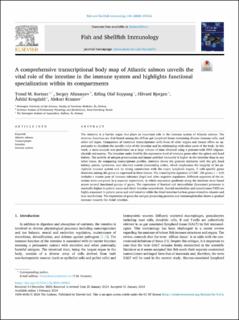| dc.contributor.author | Kortner, Trond M. | |
| dc.contributor.author | Afanasyev, Sergey | |
| dc.contributor.author | Koppang, Erling Olaf | |
| dc.contributor.author | Bjørgen, Håvard | |
| dc.contributor.author | Krogdahl, Åshild | |
| dc.contributor.author | Krasnov, Aleksei | |
| dc.date.accessioned | 2024-03-20T10:40:28Z | |
| dc.date.available | 2024-03-20T10:40:28Z | |
| dc.date.created | 2024-02-23T09:42:25Z | |
| dc.date.issued | 2024 | |
| dc.identifier.citation | Fish and Shellfish Immunology. 2024, 146 . | |
| dc.identifier.issn | 1050-4648 | |
| dc.identifier.uri | https://hdl.handle.net/11250/3123341 | |
| dc.description.abstract | The intestine is a barrier organ that plays an important role in the immune system of Atlantic salmon. The immune functions are distributed among the diffuse gut lymphoid tissue containing diverse immune cells, and other cell types. Comparison of intestinal transcriptomes with those of other organs and tissues offers an opportunity to elucidate the specific roles of the intestine and its relationship with other parts of the body. In this work, a meta-analysis was performed on a large volume of data obtained using a genome-wide DNA oligonucleotide microarray. The intestine ranks third by the expression level of immune genes after the spleen and head kidney. The activity of antigen presentation and innate antiviral immunity is higher in the intestine than in any other tissue. By comparing transcriptome profiles, intestine shows the greatest similarity with the gill, head kidney, spleen, epidermis, and olfactory rosette (descending order), which emphasizes the integrity of the peripheral mucosal system and its strong connections with the major lymphoid organs. T cells-specific genes dominate among the genes co-expressed in these tissues. The transcription signature of CD8+ (86 genes, r > 0.9) includes a master gene of immune tolerance foxp3 and other negative regulators. Different segments of the intestine were compared in a separate experiment, in which expression gradients along the intestine were found across several functional groups of genes. The expression of luminal and intracellular (lysosome) proteases is markedly higher in pyloric caeca and distal intestine respectively. Steroid metabolism and cytochromes P450 are highly expressed in pyloric caeca and mid intestine while the distal intestine harbors genes related to vitamin and iron metabolism. The expression of genes for antigen presenting proteins and immunoglobulins shows a gradual increase towards the distal intestine. | |
| dc.language.iso | eng | |
| dc.title | A comprehensive transcriptional body map of Atlantic salmon unveils the vital role of the intestine in the immune system and highlights functional specialization within its compartments | |
| dc.title.alternative | A comprehensive transcriptional body map of Atlantic salmon unveils the vital role of the intestine in the immune system and highlights functional specialization within its compartments | |
| dc.type | Peer reviewed | |
| dc.type | Journal article | |
| dc.description.version | publishedVersion | |
| dc.source.pagenumber | 0 | |
| dc.source.volume | 146 | |
| dc.source.journal | Fish and Shellfish Immunology | |
| dc.identifier.doi | 10.1016/j.fsi.2024.109422 | |
| dc.identifier.cristin | 2249076 | |
| cristin.ispublished | true | |
| cristin.fulltext | original | |
| cristin.qualitycode | 1 | |
